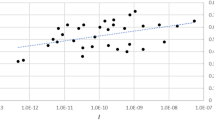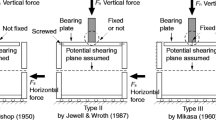Abstract
Direct shear test has been widely used to measure the shear strength of soils and other particulate materials in industry because of its simplicity. However, the results can be dependent on the specimen size. The ASTM (American Society for Testing and Materials) publications suggest that for testing soils the shear box should be at least ten times the diameter of the largest particle and the height of the box should be no more than half of its diameter. These guidelines are empirically based. A series of two-dimensional numerical direct shear tests are performed to investigate this scaling effect. By analyzing the bulk friction, particle translation and rotation, percentage of sliding, average volume (area) and shear strain and the evolution of the shear band, we find that the traditional guidelines for direct shear tests are questionable. Scaling dependency of bulk friction on the property of granular materials is clearly present. Our current analysis points out that the scaling effects can vary significantly depending on the particle properties other than their sizes. Of all the parameters we observed, particle rotation appears to have a decisive correlation with the bulk friction. Formation of a shear band is universal. As the shearing progresses, particle rotation begins to concentrate near the shear plane. By defining the width of a shear band as the standard deviation of the distribution of translational gradient or the standard deviation of the distribution of particle rotation, quantitative evolutions of shear band are presented. Both measures of the shear band width dropped rapidly during pre-failure stage. After peak stress both measures begin to approach steady state as the bulk friction stabilizes to the residual stage. These observations suggest that structure formation inside the shear band controls the scaling effect.
Similar content being viewed by others
References
Terzaghi K, Peck R B, Mesri G. Soil Mechanics in Engineering Practice. 3rd ed. New York: Wiley, 1996
Leshchinsky D. Design dilemma: Use peak or residual strength of soil. Geotext Geomembranes, 2001, 19: 111–125
Parsons J D. Progress report on an investigation of the shearing resistance of cohesionless soils. In: Proceedings of the 1st International Conference on Soil Mechanics and Foundation Engineering, 1936. 133–138
Cerato A B, Lutenegger A J. Specimen size and scale effects of direct shear box tests of sands. Geotech Test J, 2006, 29: 507–516
Satake M. Fabric tensors in granular materials. In: Proceedings IUTAM Conference on Deformation and Failure of Granular Materials, Delft, 1982. 63–68
Madadi M, Tsoungui O, Lätzel M, et al. On the fabric tensor of polydisperse materials in 2d. Int J Solids Struct, 2004, 41: 2563–2580
Chang C S, Hicher P Y. An elasto-plastic model for granular materials with microstructural consideration. Int J Solids Struct, 2005, 42: 4258–4277
Nicot F, Darve F, RNVO group. A multi-scale approach to granular materials. Mech Mater, 2005, 37: 980–1006
Al Hattamleh O, Mühunthan B, Zbib H M. Multi-slip gradient formulation for modeling microstructure effects on shear bands in granular materials. Int J Solids Struct, 2007, 44: 3393–3410
Peters J F, Muthuswamy M, Wibowo J, et al. Characterization of force chains in granular material. Phys Rev E, 2005, 72: 041307
Kuhn M R, Chang C S. Stability, bifurcation, and softening in discrete systems: A conceptual approach for granular materials. Int J Solids Struct, 2006, 43: 6026–6051
Muthuswamy M, Peters J, Tordesillas A. Uncovering the secrets to relieving stress: discrete element analysis of force chains in particulate media. ANZIAM J, 2006, 47: C355–C372
Estrada N, Taboada A. Shear strength and force transmission in granular media with rolling resistance. Phys Rev E, 2008, 78: 021301
Zhang L, Thornton C. DEM simulations of the direct shear test. In: 15th ASCE Engineering Mechanics Conference, Columbia University, New York, 2002
Cundall P A, Strack O D L. A discrete numerical model for granular assemblies. Geotechnique, 1979, 29: 47–65
Babic M, Shen H H, Shen H T. The stress tensor in granular shear flows of uniform, deformable disks at high solids concentrations. J Fluid Mech, 1990, 219: 81–118
Mitchell J K. Fundamentals of Soil Behavior. 2nd ed. New York: Wiley, 1993
Oda M, Iwashita K. Study on couple stress and shear band development in granular media based on numerical simulation analyses. Int J Eng Sci, 2000, 38: 1713–1740
Mühlhaus H B, Vardoulakis I. The thickness of shear bands in granular materials. Geotechnique, 1987, 37: 271–283
Rechenmacher A L. Grain-scale processes governing shear band initiation and evolution in sands. J Mech Phys Solids, 2006, 54: 22–45
Qin J. Investigation of mechanical properties of geomaterials based on DEM simulation and theories for strain localization analysis. Dissertation for the Doctoral Degree. Dalian: Dalian University of Technology, 2007
Iwashita K, Oda M. Rolling resistance at contacts in simulation of shear band development by DEM. J Eng Mech, 1998, 124: 285–292
Bardet J P, Proubet J. The structure of shear bands in idealized granular materials. Appl Mech Rev, 1992, 45: S118–122
Kuhn M R. Structured deformation in granular materials. Mech Mater, 1999, 31: 407–429
Tordesillas A. Force chain buckling, unjamming transitions and shear banding in dense granular assemblies. Philos Mag, 2007, 87: 4987–5016
Author information
Authors and Affiliations
Corresponding author
Additional information
Supported by the ASEE/NASA Summer Faculty Fellowship Program and Clarkson University
About this article
Cite this article
Zhou, Q., Shen, H.H., Helenbrook, B.T. et al. Scale dependence of direct shear tests. Chin. Sci. Bull. 54, 4337–4348 (2009). https://doi.org/10.1007/s11434-009-0516-5
Received:
Accepted:
Published:
Issue Date:
DOI: https://doi.org/10.1007/s11434-009-0516-5




